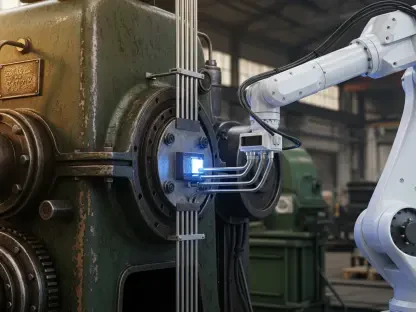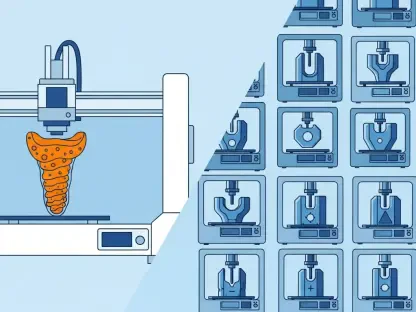The article “Selling Services: How OEMs Can Use Smart Data to Generate a New Revenue Stream” explores the growing relevance of smart technologies for Original Equipment Manufacturers (OEMs) and their potential to create new revenue streams through the application of data-driven services. The overarching theme of the article is the transformation from traditional product sales to service-oriented models leveraging smart data analytics to enhance customer value. The subject of analysis revolves around how integrating smart technologies on the manufacturing plant floor can unlock substantial benefits, particularly in terms of efficiency and operational insights. According to research cited from McKinsey & Company, the use of smart data analytics can increase manufacturing efficiency by nearly 20%. This improvement presents OEMs with a unique opportunity to assist their customers in achieving data goals and developing new service offerings that capitalize on the wealth of data generated by these advanced technologies.
The Shift from Product Sales to Service-Oriented Models
Traditionally, OEMs focused primarily on product design and sales. However, the integration of smart technologies calls for an expansion of this role to include data services that deliver actionable insights. By leveraging smart data feeds from components like Programmable Logic Controllers (PLCs) and edge devices, OEMs can offer enhanced value, aiding in next-generation remote access, performance analytics, and predictive maintenance. This shift represents a strategic departure from conventional practices, aiming to enrich customer relationships through ongoing, data-driven service interactions, and machinery design improvements. Consequently, the role of OEMs is evolving, leading to new possibilities for revenue generation through the continuous interaction and support provided to customers.
A notable aspect of this transformation is the strategic advantage that smart data provides. Instead of merely selling a product, OEMs now have the opportunity to develop long-term relationships with their customers by offering continuous monitoring and insights that can help optimize machine performance. This emphasis on service not only enhances customer satisfaction but also positions OEMs as indispensable partners who provide value beyond the initial sale. By taking an active role in the ongoing performance and maintenance of their machines, OEMs can create additional revenue streams through service contracts and data analytics services, ultimately fostering loyalty and deeper customer engagement.
Performance Analytics: Enhancing Machine Optimization
Continuously monitoring the performance of machines in the field is crucial for effective troubleshooting and machine optimization. OEMs can gain early insights into operator adjustments that may not be optimal, allowing them to address potential performance issues proactively. This process also provides training opportunities for operators and enables the collection of data that can inform future product development and design improvements. Performance analytics not only help in identifying inefficiencies but also in understanding the root causes of these issues. By analyzing data trends, OEMs can recommend best practices and adjustments to improve machine performance. This proactive approach ensures that machines operate at peak efficiency, reducing downtime and increasing overall productivity.
Furthermore, performance analytics provide OEMs with a wealth of data that can be used to enhance future products. By understanding how their machines perform in real-world scenarios, OEMs can make informed decisions about design enhancements and feature updates. This continuous feedback loop between the field and the development team fosters innovation and ensures that new models are better suited to meet customer needs. Ultimately, leveraging performance analytics helps OEMs stay competitive in a rapidly evolving market by constantly improving their offerings and meeting the high expectations of modern manufacturers who demand efficiency and reliability.
Predictive Maintenance: Reducing Downtime and Enhancing Reliability
Predictive maintenance has evolved from a novel concept into a practical solution enabled by smart sensors and technologies. By analyzing data from connected machines, OEMs can predict potential machine failures and recommend preemptive maintenance actions. This not only helps in reducing downtime but also enhances machine reliability and customer satisfaction. Examples of predictive maintenance include vibration sensors that detect abnormalities in machine operations and alert users when service might be needed based on runtime statistics. Implementing predictive maintenance allows OEMs to offer a higher level of service to their customers. By preventing unexpected breakdowns, OEMs can ensure that their machines remain operational for longer periods, thereby increasing customer trust and loyalty.
This service-oriented approach also opens up new revenue streams through maintenance contracts and service agreements. Customers are often willing to pay for the peace of mind that comes with knowing that potential issues can be identified and resolved before they lead to costly downtime. By offering predictive maintenance as a service, OEMs can differentiate themselves from competitors and establish a reputation for reliability and support. This not only strengthens customer relationships but also creates a recurring revenue model that benefits both OEMs and their clients. The ability to predict and address issues proactively demonstrates the tangible value of smart data and underscores the importance of investing in advanced sensor technologies and data analytics capabilities.
Remote Access: Efficient Troubleshooting and Problem-Solving
Remote troubleshooting has become increasingly important due to pressures to maintain high machine uptime and efficiency. Without remote access, addressing machine issues involves significant delays due to the need for technicians to travel to the site. With remote access capabilities, a technician can diagnose and solve problems from virtually any location, minimizing downtime and lost productivity. This method is not only efficient but also enables OEMs to directly observe issues, which can then be factored into future machine design improvements. Remote access also allows OEMs to provide real-time support to their customers. By offering remote diagnostics and troubleshooting services, OEMs can quickly address any issues that arise, ensuring that their customers’ operations run smoothly.
This capability not only enhances customer satisfaction but also positions OEMs as reliable partners in the manufacturing process. The convenience and speed of remote troubleshooting can be a significant selling point for customers who prioritize operational efficiency and minimal disruption. Additionally, the insights gathered through remote diagnostics can inform product development by highlighting common issues and areas for improvement. As manufacturers increasingly adopt smart technologies, the ability to offer remote support will become a standard expectation, making it a critical component of an OEM’s service portfolio. By investing in robust remote access solutions, OEMs can stay ahead of the competition and demonstrate their commitment to providing comprehensive support.
Overall Equipment Effectiveness (OEE): Maximizing Efficiency
Maximizing OEE is a priority for manufacturers, but pinpointing the exact cause of inefficiencies can be challenging. By providing comprehensive data on performance losses, OEMs can help manufacturers identify and address problems, whether they originate from the OEM’s machine or elsewhere in the production line. This capability supports continuous operations and reduces downtime, positioning OEMs as value-added partners in the manufacturing process. By focusing on OEE, OEMs can offer targeted solutions to improve overall production efficiency. This involves analyzing data to identify bottlenecks, recommending process improvements, and implementing changes that enhance machine performance. By doing so, OEMs can help their customers achieve higher levels of productivity and profitability.
The emphasis on OEE underscores the importance of detailed data analysis and targeted recommendations. OEMs that excel in this area can differentiate themselves by demonstrating their ability to deliver measurable improvements in performance. By positioning themselves as experts in efficiency optimization, OEMs can build strong, trust-based relationships with their customers. This not only creates opportunities for service contracts and ongoing support but also enhances the overall value proposition of their products. Ultimately, the ability to maximize OEE can become a key differentiator in a competitive market, attracting customers who seek to optimize their manufacturing processes and achieve higher levels of operational excellence.
Building Smart Data Capabilities: A Competitive Advantage
The article “Selling Services: How OEMs Can Use Smart Data to Generate a New Revenue Stream” discusses how smart technologies are increasingly relevant for Original Equipment Manufacturers (OEMs) and their potential to create new revenue through data-driven services. The article’s main theme is the shift from traditional product sales to service-oriented models that use smart data analytics to increase customer value. It examines how smart technologies in manufacturing can deliver significant benefits, particularly in efficiency and operational insights. Research from McKinsey & Company indicates that smart data analytics can boost manufacturing efficiency by about 20%. This improvement offers OEMs a unique chance to help their customers achieve data goals and create new service offerings. They can leverage advanced technologies to harness the abundant data generated, presenting OEMs with a valuable opportunity to innovate and enhance customer relationships. By embracing these smart technologies, OEMs not only transform their business models but also discover new avenues for growth and profitability.









